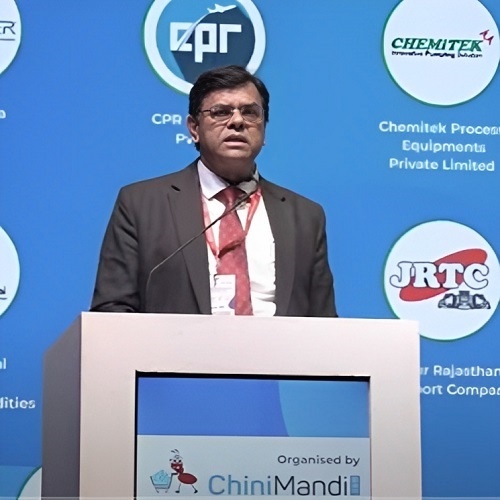The Indian government is leaving no stone unturned to boost ethanol production to ensure it achieves a 20 percent ethanol blending target by 2025. The government has announced various initiatives and measures to encourage biofuel production; however, recently, distilleries had to stop their operations due to the halt of subsidized rice supply from the Food Corporation of India. Later on, Oil Marketing Companies (OMCs) again increased prices of ethanol made from rice and maize to help distilleries restart production. Let us understand from the expert what the bottlenecks are in boosting and achieving the ethanol production target set by the government.
In an exclusive interview with ChiniMandi, Abinash Verma, Ex-DG of ISMA, former Bureaucrat with GOI, and now promoter of Eastern India Biofuels Pvt Ltd, shared his views on the current ethanol industry scenario and the hurdles that need to be addressed to achieve the ethanol blending target.
How important do you think will be the contribution of the grain based distilleries in India’s ethanol blending programme and in achieving the 20% blending target by 2025?
Government of a India’s think tank, Niti Aayog, after consulting all Ministries responsible and relevant in the value chain of ethanol production, from feedstock to blending, has established that to achieve 20% ethanol blending with petrol in 2025, we would need 10.20 billion litres of ethanol, and for that our alcohol production capacity (to also cater to the demand of chemical and liquor sector), should be around 15 billion litres. Considering that there is a limit to surplus sugarcane getting diverted for ethanol production, Niti Aayog has also established that 7.6 billion litres of production capacity will be required with sugarcane based distilleries and balance 7.4 billion litres will have to be with grain based distilleries. Current capacities would be around 5 billion litres with sugarcane distilleries and just about 1.2 billion litres with the grain based distilleries. Clearly, if India has to achieve its 20% ethanol blending with petrol, the grain based distilleries have to grow by at least 5 times. Otherwise, India will miss its target by few billion litres.
How has the discontinuation of broken rice supply by FCI affected the operations of grain based distilleries?
The sudden stoppage of supply of surplus FCI rice/grain (SFG) to distilleries on 22 July 2023, has not only stopped operations of most of the grain based distilleries, immediately or subsequently, but has unfortunately also shaken the confidence of all stakeholders. FCI even returned payments made for supply of surplus rice and in fact even cancelled Delivery/Release Orders issued, including DOs/ROs against which part supplies were already made.
All of us understand that investments require stable and transparent policies and this sudden decision has shaken up the industry. The Banks/Lenders have started rejecting ethanol loan applications or postponing taking decisions on the same. The enthusiasm and excitement about investing in ethanol in India seems to be waning away.
The question is why FCI’s SFG supplies were so important at this time? On 22nd July, the ethanol prices as fixed by OMCs were the highest, if produced from SFG at Rs.58.50 per litre, whereas that produced from maize fetched Rs.56.35 per litre and that from broken rice/damaged foodgrain (DFG) was paid at Rs.55.54 per litre. However, while SFG was supplied by FCI at Rs.20,000 per ton, the market price of maize and broken rice were at Rs.22,000 to 24,000 per ton. With grain based distilleries just about recovering their costs if they used SFG, it did not make any economic sense to produce ethanol from either maize or DFG and lose more.
Are the prices of broken rice currently elevated in the open market, and are the distilleries considering procuring it from there to sustain ethanol production?
The current price of broken rice supplied FOR distillery gate is around Rs.23,000-24,000 per ton, depending on the distance they are from rice millers, which are the source of broken rice. SFG from FCI are full grain rice with hardly any dust or moisture, and distilleries generally recover 450 litres from each ton of SFG. On the other hand, broken rice has lot of foreign material including husk and moisture. Starch content is much lower in broken rice, because of which the distilleries get only about 440 litres, or even lower depending on the quality of broken rice. It didn’t make sense to distilleries to use broken rice instead of SFG then.
However, the OMCs have increased the ethanol price from broken rice wef 7th Aug by Rs.4.75 to Rs.60.29 per litre. Several distilleries still feel it’s not enough to cover for the higher cost of broken rice and lower yield as compared to SFG from FCI. However, it is allowing some distilleries, having lower interest burden and transport costs, to break even. However, if broken rice prices remain at current levels, especially when there is fear of lower rice production this year, this ethanol price of Rs.60.29 per litre will need another major hike, to encourage use of broken rice to produce ethanol.
In light of the halted supply, what strategic plans are the distilleries reworking to ensure continuity of their operations?
The Government wants to encourage maize use for ethanol, and has even hinted at strategies to increase maize production in the country. We also think that there is a massive potential of increasing maize productivity in India, which if increased from the current 3.4 tons per hectare to 4.6-4.7 tons (still below World average of 6 tons/hectare) will be sufficient for the additional 12-13 million tons of maize to meet the supply requirement of ethanol from grain based distilleries for 20% blending.
The OMCs have also increased maize based ethanol price by Rs.6.01 to Rs.62.36 per litre wef 7th Aug. At current maize prices, distilleries feel they will just about break even. But the uncertainty of starch content in the maize and quality of maize currently available, it is not easy for most of the grain based distilleries to run their operations satisfactorily. Distilleries are reporting starch content of as low as 58% giving them ethanol recovery of around 365-370 litres only.
We believe that maize is the grain which will be the most used and most easily available feedstock to grain based distilleries in the long run. Maize has the potential of replacing the SFG from FCI, but the ethanol prices will need to be reworked by OMCs to make this a reality.
As of now, what kind of support or assistance do the distilleries expect from the government to ensure smooth and uninterrupted operations?
As mentioned above, massive investments are required to be made in ethanol production capacities to be able to produce 10.2 billion litres of ethanol in 2025. So, the first and most important expectation from the Government is stable and transparent policies on ethanol. The recent decision of FCI to suddenly stop all supplies of SFG for ethanol production should not be allowed to happen again. Secondly, till such time we are able to produce around 48-50 million tons of maize annually in the country, FCI surplus rice should be continued to be supplied and made available continuously. This is also important from the point of view of the Banks/Lenders who have serious questions on continuous and adequate availability of feedstock at reasonable price for ethanol production. Thirdly, as market prices of agri-products are pretty volatile between seasons or in a year or two, depending on various factors like rainfall or world prices too, the Government should be ready and willing to revise and fix ethanol prices at reasonable levels. Lastly, the current ethanol prices fixed/ revised from 7th Aug needs to be reviewed as quickly as possible by an independent expert committee of Joint Secretaries of GOI, and approved by the Union Cabinet, like what is done for ethanol prices for sugarcane/molasses based ethanol.
With the current demand to raise ethanol prices, what price range would be considered favorable for the industry’s interests?
Considering a price for ethanol at Rs.58.50 per litre produced from surplus FCI rice supplied at Rs.20,000 per ton (plus an average transport cost of Rs.500 per ton) and ethanol recovery of 450 litres per ton of FCI rice, where the price of FCI rice per litre of ethanol works out to Rs.45.56, price of maize and broken rice based ethanol would work out to as follows:
a) Maize price of Rs.22,000 per ton and ethanol recovery of 380 litres, the per litre price of maize works out to Rs.57.89 per litre of ethanol (Rs.12.33 per litre more than FCI rice). A simple maths would suggest that the maize based ethanol price then should be around Rs.70.83 per litre, but considering distilleries get more DDGS from maize though that sells at lower price than rice DDGS, the price of maize based ethanol could be kept at Rs.69-70 per litre.
b) Broken rice price of Rs.23,000 or so per ton and ethanol recovery of 440 litres, the per litre price of broken rice works out to Rs.52.27 per litre of ethanol (Rs.6.71 per litre more than FCI rice). A simple maths would suggest that the broken rice based ethanol price then should be around Rs.65.21 per litre.












It is very technical considering the climate change and most suitable environment to grow quality sugar cane in India . We must plan to double the production of Sugar. Ethinol. Co – generation than present from sugar cane than grains. We need more grains to avoid the hunger of people from India and other countries. Grains are the major source to avoid the hunger. Dr. A.S. Patil.
[…] b) Broken rice price of Rs.23,000 or so per ton and ethanol recovery of 440 litres, the per litre price of broken rice works out to Rs.52.27 per litre of ethanol (Rs.6.71 per litre more than FCI rice). A simple maths would suggest that the broken rice based ethanol price then should be around Rs.65.21 per litre.Source: ChiniMandi […]